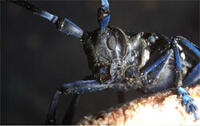HABITAT
Protecting Trees from Asian Longhorned Beetles
Around 1996, New York City was invaded by beetles. No, not the Liverpudlian singing group, but Asian Longhorned Beetles, an invasive insect pest that's a serious threat to such hardwood tree as maple and birch, found in abundance here — including on the property of cooperatives and condominiums. ALBs destroy trees by eating them from the inside out. It ain't pretty. But the city's on the alert, and you and your board can get the resources to rescue your trees.
Robert D'Amico, a manager for Mark Greenberg Real Estate, learned about ALBs the hard way. Some trees on the 60-acre grounds of Georgetown Mews, a 930-unit co-op in Queens, were found to be infested and had to be removed. As D'Amico learned, the adult female beetle chews depressions into a tree's bark, in which she lays her eggs. The worm-like, immature beetles hatch and tunnel into the tree, where, all fall and winter, they feed on tissue that carries food and water from the tree's roots to its leaves. In spring, adult beetles emerge out of deep, perfectly round exit holes about the size of a pencil. Infested trees (Scroll down, click on tree image to enlarge) eventually wither and die.
A mature ALB is 1 to 1.5 inches long, has a shiny, jet-black body with white spots and long, black and white antennae. (Click on image at left to enlarge.) Adults are most evident between June and October. ALBs face no natural predator in the U.S., and while the pesticide imidacloprid is used "to protect trees from becoming infested," it isn't 100 percent effective, reports Joseph P. Gittleman, co-director of the Asian Longhorned Beetle Eradication Program/New York. And once a tree is infested, it can't be treated with pesticide, he adds. The only option then is to cut it down, chip it and burn it.
ALBs were first discovered in New York City in August 1996, in Greenpoint, Brooklyn. Other infestations have since been discovered throughout the metropolitan area. The U.S. Department of Agriculture's Animal and Plant Health Inspection Service (APHIS), reported the most recent — 13 maple trees Staten Island — on Feb. 17, 2009.
Gittleman's program, run by the U.S. Department of Agriculture and the New York Department of Agriculture and Markets, visually inspects trees to determine if they're infested; remove and properly disposes of sick trees; and treats high-risk ones to prevent infestation.
Infested areas are quarantined, which means federal and state regulations are in effect to control the handling and movement of wood within and out of those areas, says Gittleman. (Download the New York City Department of Parks and Recreation map of the quarantined zones.) This helps prevent the outbreak from reaching and destroying hardwood forests and crippling the maple syrup/sugar, lumber, tourism and furniture industries.
What can your co-op or condo do to help prevent the spread of ALBs? In the past, compliance-training workshops have been held. In addition to keeping an eye out for future workshops and keeping your eyes open for the insects — call 1-877-STOP-ALB for up-to-date information — Gittleman and D'Amico suggest you:
• Use only contractors who have compliance agreements.
Gittleman recommends that co-ops and condos that don't handle their landscaping in-house hire only contractors bearing compliance agreements with APHIS. These agreements may be initiated by contacting your local APHIS office or APHIS headquarters at: Animal and Plant Health Inspection Service, Plant Protection and Quarantine, Domestic and Emergency Operations, 4700 River Road Unit 134, Riverdale, Maryland 20737–1236.
All landscapers, tree-trimmers and other contractors who handle wood debris within quarantine areas must have compliance agreements. If you hire a contractor who improperly disposes of such wood, you might be held liable for that violation.
• Comply with wood-debris removal procedures.
Homeowners, including co-ops and condos, must comply with the city's wood-debris removal procedures when disposing of branches, tree trimmings, firewood and other wood debris. (These regulations don't apply to Christmas trees, which are softwood, notes Gittleman.) In most parts of the city, you must phone 311 to arrange for the Department of Parks and Recreation to pick up and chip any wood debris.
• Give inspectors access to property.
Gittleman says it's "very important" for you to give inspectors access to all the trees on your property — including those on penthouse terraces and in rooftop gardens. If they can catch the infestation early, you won't lose as many trees, he explains.






